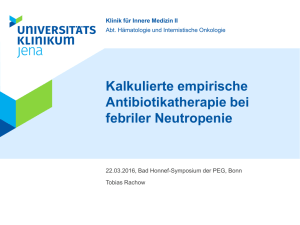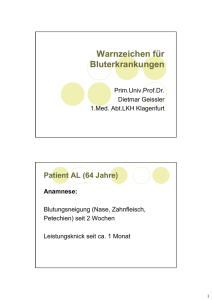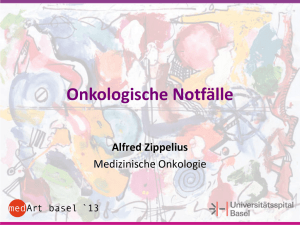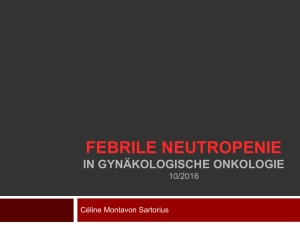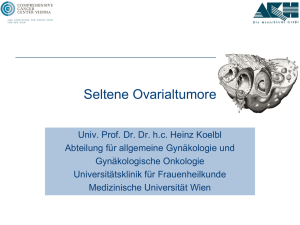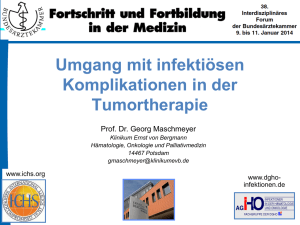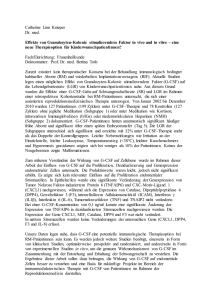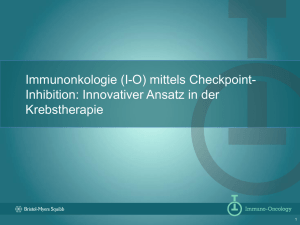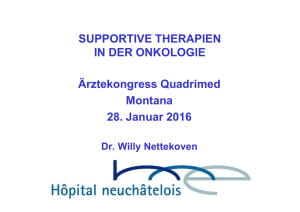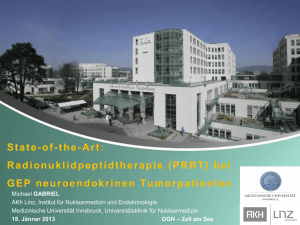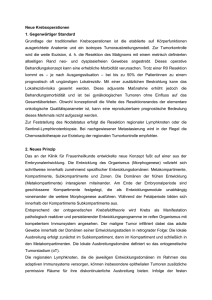Neutropenisches Fieber Univ. Prof. Dr. D. Geissler 1. Med. Abt Lkh
Werbung
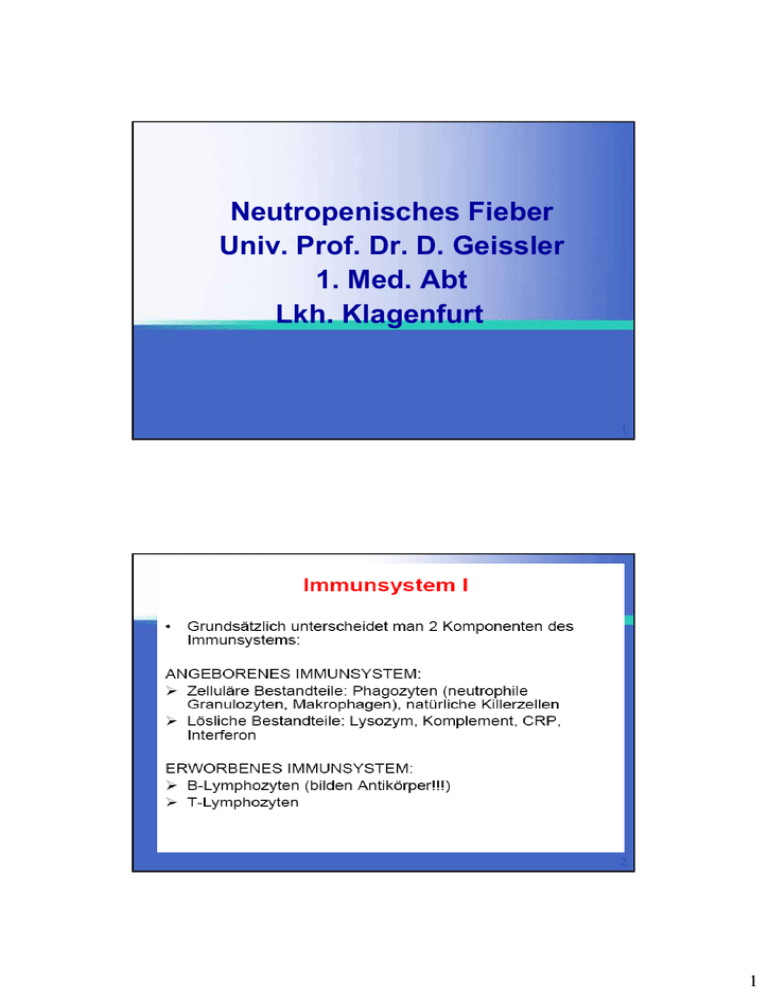
Neutropenisches Fieber Univ. Prof. Dr. D. Geissler 1. Med. Abt Lkh. Klagenfurt 1 2 1 3 4 2 Neutropeniedauer Neutropeniedauer und und Infektionsrisiko Infektionsrisiko Bodey at al, 1966 Je länger die Neutropenie, desto größer das Risiko einer schwere Infektion 5 Neutropenie und Infektionsrisiko Wilkinson und Robinson 1992 Je ausgeprägter die Neutropenie, desto größer das Risiko einer schwere Infektion 6 3 A Serious Clinical Consequence of Neutropenia: FN FN is defined by • Temperature ≥ 38.5° 38.5°C for more than 1 hour • < 0.5 x 109 neutrophils/L1-3 Incidence varies depending on • Chemotherapy regimen • Type of cancer4 5,6 • Patient risk 1factors ASCO recommendations for the use of hematopoietic colony-stimulating factors. J Clin Oncol. 1994;12:2471-2508 H, et al. J Clin Oncol. 2000;18:3558-3585 3ESMO recommendations for the application of haematopoietic growth factors (hGFs). http://www.esmo.org/reference/reference_guidelines.htm 4Boyle P, et al. J Clin Oncol. 2004;22(suppl 14):886S. Abstract 9706 5Smith TJ, et al. J Clin Oncol. 2006;24:3187-3205 6Aapro MS, et al. Eur J Cancer. 2006. In press 2Ozer 7 FN-Risiko nach dem 1. CHOP-Zyklus bei NHL Kumulative Wahrscheinlichkeit für das Auftreten einer FN 0.50 ≥65 Jahre <65 Jahre Zyklus 1 0.40 0.30 0.20 0.10 0.00 0 10 20 30 40 50 60 70 80 90 100 110 120 130 Tage bis zum ersten Auftreten einer FN Lyman G, et al. Proc Am Soc Clin Oncol. 2002;21:358a. Abstract 1430.. 8 4 Risk Factors for Neutropenia Independent and disease-related High-dose risk factors chemotherapy Prior therapy-related risk factors • Advanced age > 65 years • Low cycle one nadir ANC** • Advanced cancer • Performance status (ECOG II– II–IV) • History of recurrent chemotherapychemotherapy-induced neutropenia • Bone marrow involvement • PrePre-existing neutropenia due to Neutropenia – Extensive myelosuppressive therapy • Infection, open wounds • Renal disease* Above normal LDH* Serum albumin > 3.5 g/dL* g/dL* – Radiation therapy to pelvis or other large regions of bone marrow FN *Non-Hodgkin’s lymphoma (NHL) **Breast cancer FN = febrile neutropenia ECOG = Eastern Co-operative Oncology Group LDH = lactate dehydrogenase Silber JH, et al. J Clin Oncol. 1998;16:2392-2400 Scott S. Am J Health Syst Pharm. 2002;59(15 suppl 4):S16-S19 Ozer H, et al. J Clin Oncol. 2000;18:3558-3585 Crivellari D, et al. J Clin Oncol. 2000;18:1412-1422 9 FN is Associated with Mortality Inpatient mortality (% patients admitted for FN) 25 Mortality following hospital admission for FN* (1995–2000) ≥ 21.4 20 15 5 0 10.3 9.5 10 2.6 Overall (n = 41,779) *Data based on a single admission per patient No major comorbidity (n = 21,386) 1 major comorbidity (n = 12,398) > 1 major comorbidity (n = 7,995) Kuderer NM, et al. Cancer. 2006;106:2258-2266 10 5 EORTC and ASCO G-CSF Guideline-Based FN Assessment STEP 1: Assess FN risk for the planned chemotherapy regimen • The patient’ patient’s FN risk should be routinely assessed prior to each chemotherapy chemotherapy cycle • DoseDose-dense chemotherapy regimens should always be considered high risk risk for FN (FN risk ≥ 20%)1 • Patients with NHL > 65 years receiving curative chemotherapy should should be considered at high risk of FN2 FN risk ≥ 20% FN risk 10%–20% FN risk < 10% STEP 2: Assess factors that may increase the risk of FN PROPHYLACTIC G-CSF RECOMMENDED • Age ≥ 65 years1,2 • Haemoglobin < 12 g/dL1 • Poor performance status1,2 • Poor nutritional status1,2 • Advanced disease1,2 • Combined chemoradiotherapy2 • Serious coco-morbidities2 • Previous episode of FN1,2 • Cytopenias due to tumour bone marrow involvement2 • Open wounds or active infections2 • Female G-CSF USE NOT INDICATED gender1 Overall FN risk ≥ 20% Overall FN risk < 20% NHL = non-Hodgkin’s lymphoma This algorithm represents a combined interpretation of the 2006 G-CSF guidelines of EORTC and ASCO 1 Aapro 2Smith MS, et al. Eur J Cancer. 2006. In press TJ, et al. J Clin Oncol. 2006;24:3187-3205 11 Pluripotential Stem Cell Hämatopoetische flkflk-2/flt2/flt-3 ligand SCF Wachstumsfaktoren CFUCFU-Blast flkflk-2/flt2/flt-3 ligand SCF flkflk-2/flt2/flt-3 ligand SCF CFUCFU-GEMM SCF ILIL-3 MGDF/TPO SCF ILIL-3 BFUBFU-E SCF ILIL-3 GMGM-CSF EPO SCF ILIL-3 flkflk-2/flt2/flt-3 ligand CFUCFU-Meg SCF ILIL-3 GMGM-CSF ILIL-11 ILIL-6 MGDF/TPO CFUCFU-E CFUCFU-G ILIL-3 GMGM-CSF EPO ILIL-3 GMGM-CSF G-CSF Lymphoid Stem Cell SCF ILIL-3 CFUCFU-GM ILIL-3 GMGM-CSF G-CSF flkflk-2/flt2/flt-3 ligand SCF CFUCFU-Eo SCF ILIL-3 CFUCFU-Ba SCF ILIL-3 SCF flkflk-2/flt2/flt-3 ligand ILIL-7 CFUCFU-Mast NK Precursor SCF flkflk-2/flt2/flt-3 ligand ILIL-7 PrePre-B Cell PrePre-T Cell ILIL-7 ILIL-3 GMGM-CSF CFUCFU-M ILIL-3 GMGM-CSF M-CSF ILIL-3 GMGM-CSF ILIL-3 ILIL-3 SCF ILIL-6 ILIL-2 ILIL-7 SCF ILIL-2 Megakaryocyte Proplatelets Monocyte B Lymphocyte GMGM-CSF M-CSF Reticulocyte Red Blood Cell Neutrophil Platelets Eosinophil Macrophage Tissue Mast Cell Basophil T Lymphocyte Plasma Cell NK Cell 12 6 Neupogen® • Filgrastim • Hämatopoetischer Wachstumsfaktor • stimuliert neutrophile Granulozyten nach Hill et al., Proc Natl Acad Sci 90, 1993 13 Wirkung auf das Knochenmark 14 7 Klinischer Nutzen Crawford et al., 1991 15 Pegfilgrastim = pegyliertes Filgrastim Filgrastim Helikales Bündel Pegfilgrastim Helikales Bündel N-terminales Ende 18.800 Dalton renal1 täglich3 Molekulargewicht Primärer Eliminationsweg Verabreichung Polyethylenglykol (PEG) 39.000 Dalton Neutrophilen-vermittelt2 1x/CT-Zyklus4 1. Roskos et al, Clin Pharmacol Ther 1999; Amgen, data on file; 2. Johnston et al, J Clin Oncol 2000; Roskos et al, Clin Pharmacol Ther 1999; Amgen, data on file; 3. Fachinformation Neupogen®, Stand März 2002; 4. Fachinformation Neulasta®, Stand August 2002 16 8 Prolonged Action with Neulasta®® (Pegfilgrastim) Neulasta® • Pegylated filgrastim Æ longer action • Provides sustained stimulation of neutrophil production during neutropenia neutropenia ® • SelfSelf-regulated clearance mechanism allows Neulasta to clear as the neutrophils recover ANC Neulasta® 100 µg/kg (n = 3) 1,000 100 10 10 1 1 0.1 0.01 0.1 0 5 10 15 Day 20 25 Median serum concentration (µg/L) Median ANC 9 (× 10 /L) 100 0.01 Molineux G, et al. Exp Hematol. 1999;27:1724-1734 Graph adapted from Johnston E, et al. J Clin Oncol. 2000;18:2522-2528 17 Neulasta®® (Pegfilgrastim) Showed a 63% Relative Reduction in FN Incidence Incidence of FN (%) 30 25 20 17.1% 15 63% 10 6.4% 5 0 Daily G-CSF Neulasta® Adapted from von Minckwitz G, et al. J Clin Oncol. 2005;23(suppl):731. Abstract 8008 18 9 Vorteile der Prophylaxe Wirkung Parameter Prophylaxe Therapie Inzidenz febriler Neutropenien + - Inzidenz dokumentierter Infektionen + - Dauer febriler Neutropenien + + Tage mit Fieber + - Antibiotikagabe + +/- Krankenhausaufenthalte + +/- Neutropenie-bedingte Mukositiden + n.a. Dosisreduktion und Intervallverlängerung + n.a. 19 Probability of overall survival Full-Dose Chemotherapy on Schedule Increases the Likelihood of Survival for NHL Patients 1.00 RDI > 90% RDI < 90% 0.75 0.50 0.25 0 0 RDI = relative dose intensity 50 100 Months of observation 150 Pettengell R, et al. Eur J Cancer. 2006. Abstract 0185 20 10 NCCN Richtlinien für das Management älterer Krebspatienten • Primä Primärprophylaxe mit Wachstumsfaktoren bei Patienten >70, die CHOP oder eine Chemotherapie ähnlicher Intensitä Intensität erhalten (CAF, FEC 100, AC) • Primä Primärprophylaxe mit Wachstumsfaktoren bei AMLAMLPatienten >60 nach InduktionsInduktions- und KonsolidierungsKonsolidierungstherapie 21 Balducci L, et al. Oncologist. 2000;5:224-237. Primäre vs. sekundäre Prophylaxe • Primä Primäre Prophylaxe – ab der ersten Chemotherapie Inzidenz einer febrilen Neutropenie>20% Neutropenie>20% z.B.SZT;DHAP;TAC – Dosis intenivierte Chemo.:z.B.:CHOPChemo.:z.B.:CHOP-14;BEACOPP int – Besoderes Risiko:alte P. mit NHL • Sekundä Sekundäre Prophylaxe: – nach schwerer Neutropenie < 500/µ 500/µl und/oder und/oder Fieber – wenn Therapieziel gefä gefährdet 22 11 Einteilung FN • FUO: fewer of unknown origin • Klinisch gesicherte Infektion: eindeutig lokalisierter Befund ( zb. zb. Pneumonie) 23 Einteilung nach Risiko • Ausmaß Ausmaß d. Neutropenie (<500/ul) • Dauer d. Neutropenie Niedrig Risiko: < 5d Standardrisiko: 66-9d Hochrisiko: >10d 24 12 Einteilung nach Risiko • Schwere der Infektion: septischer Schock Lungeninfiltrate ZNSZNS-Infektion 25 Gesicherte Infektion • Bacteriä Bacteriämie: mie: pos. Blutkultur ( zwei separat abgenommene BK) • Lungeninfiltrate: Lungeninfiltrate: Bronchoskopie u. BAL • Abdominelle Infektionen: gestö gestörte SHSH-Barriere, Stuhlkulturen • Katheterinfektion: ZVK, PAC, gerö gerötete Einstichstelle • Harnwegsinfekte 26 13 Erregerspektrum Erregernachweis in ca. 50% • Grampos. Grampos. Bakt.: Bakt.: koagulase neg. neg. Staph. Staph. Staph. Staph. aureus Streptokokken spp. spp. Enterokokken Corynebact. Corynebact. 27 Erregerspektrum • Gram neg: neg: E. coli Klebsiellen Pseudomonas aeruginosa • Anaerobier: Anaerobier: Clost. Clost. difficile Propionibact. Propionibact. spp. spp. • Pilze: Candida spp. spp. Aspergillus spp. spp. 28 14 Infektionsmanifestationen • Fieber > 38° 38°C • Bacteriä Bacteriämie • Sepsis, sept. sept. Schock • Pneumonie • Hautinfektionen: Punktionsstellen PAC venö venöse Zugä Zugänge 29 Infektionsmanifestation • orale Mucositis • nekrotisierende Stomatitis • Parodontitis • Pharyngitis • Sinusitis • Ösophagitis • Enterokolitis, Enterokolitis, fieberhafte Diarrhoe • Perianale od. urogenitale Infektion 30 15 Klinische Diagnostik • HautHaut- SHSH- Verä Veränderungen • Eintrittsstellen zentraler od. peripherer Venenzugä Venenzugänge, PAC! • exakte klinische Untersuchung • Rö-Pulmo • CTCT-Diagnostik • OBOB-Sono 31 Mikrobiologische Diagnostik • Blutkulturen: peripher, ZVK, PAC aerob/anaerob jeweils 2 separat abgenom. abgenom. • Harnkultur • Stuhlkultur bei Diarrhoe: Diarrhoe: inkl. Clost. Clost. Diff. Diff. Candida Enterotoxin, Enterotoxin, 32 16 Mikrobiologische Diagnostik • Wundabstrich • Liquorkultur • Punktionsmaterial (Pleura, Aszites,… Aszites,…) 33 Diagnostische Kriterien für Pilzinfektionen • Kulturnachweis aus sterilem Material: Blut Pleuraerguss BAL Lungenbiopsat • Histolog. Histolog. Nachweis • neu aufgetretene Lungeninfiltrate (CT!) 34 17 Therapie allgemeine Richtlinien • Patienteninformation: Auftreten von Fieber • Fieber hä häufig einziges Infektionszeichen • Sofortige (< 2h) empirische Therapie • Ergä Ergänzung nach Kulturergebnis u. Antibiogramm • Ergä Ergänzung bei fehlendem Ansprechen nach 72h • Empirische antimykotische Therapie • ZweitZweit-Mehrfachinfektionen ausschließ ausschließen 35 Initialtherapie Hoch-Standardrisiko Neutropenie < 500/ul fü für > 5 Tage • Cephalosporine (3/4 Generation) Cefepim 3x2g, Cefpirom 2-3x2g oder Piperacillin/ Piperacillin/Tazobactam 3x4,5g • Ergä Ergänzung mit Aminoglycosiden 36 18 Initialtherapie Niedrigrisiko • Peroral: Peroral: Ciprofloxacin 3 x 500mg Komb. Komb. mit Amoxicillin/ Amoxicillin/Clavulansä Clavulansäure 3 x 625mg • i.v.: i.v.: Cephalosporine: Cephalosporine: Ceftriaxon 1 x 2g Ceftazidim 3 x 2g Cefepim 2 x 2g 37 Infektionsprophylaxe • Expositionsprophylaxe: Hä Händedesinfektion Nahrungsmittel Bauarbeiten • Umkehrisolation • Selektive orale antibiotische Prophylaxe • Wachstumsfaktoren 38 19 Antibakterielle /-mykotische Substanzen • Cotrimoxazol • Colistin • Ciprofloxacin • Amphothericin B Suspension • Nystatin • Fluconazol • Posaconazol 39 Modifikation nach 72 h Hochrisiko • persistierendes neutropenisches Fieber • CRPCRP-Anstieg • Wiederholung d. Diagnostik: Rö-Pulmo CTCT-Lunge • Umstellung: Carbapeneme: Carbapeneme: Imipenem Meropenem und Glycopeptide: Glycopeptide: Vancomycin Teicoplanin 40 20 Antimykotika - Therapie • anhaltendes neutropenisches Fieber > 7 Tage • Auftreten von neuen Lungeninfiltraten: Lungeninfiltraten: • Amphothericin B, liposomales AmphoAmphothericin B, Fluconazol, Fluconazol, Voriconazol, Voriconazol, Caspofungin ,Posaconazol ATYPISCHE PNEUMONIE? CMV? PNEUMOCYSTIS C:? 41 42 21 43 44 22 Ende 45 23
